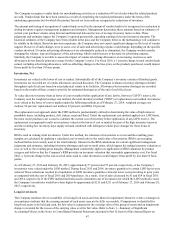Albertsons 2016 Annual Report Download - page 55
Download and view the complete annual report
Please find page 55 of the 2016 Albertsons annual report below. You can navigate through the pages in the report by either clicking on the pages listed below, or by using the keyword search tool below to find specific information within the annual report.
53
contributions to these plans, it could trigger a partial or complete withdrawal that would require the Company to fund its
proportionate share of a plan’s unfunded vested benefits.
Based on the assessment of the most recent information available from the multiemployer plans, the Company believes that
most of the plans to which it contributes are underfunded. The Company is only one of a number of employers contributing to
these plans and the underfunding is not a direct obligation or liability of the Company. However, the Company has attempted,
as of February 27, 2016, to estimate its “proportionate share” of the underfunding of multiemployer plans to which the
Company contributes, based on the ratio of its contributions to the total of all contributions to these plans in a year. As of
February 27, 2016, using methods the Company believes are consistent with those used by the plans to establish the
underfunded position, the estimate of the Company’s share of the underfunding of multiemployer plans to which it contributes
was $587, pre-tax, or $359, after-tax. This represents an increase in the Company's estimated proportionate share of the
underfunding of approximately $140, pre-tax, or $51, after-tax, as of February 27, 2016, compared to February 28, 2015. The
increase in the Company’s proportionate share of underfunding is primarily attributable to lower than anticipated returns on
assets. The estimate is based on the most current information available to the Company including actuarial evaluations and
other data, and may be outdated or otherwise unreliable. The Company’s proportionate share of underfunding described above
is an estimate and could change based on the results of collective bargaining efforts, investment returns on the assets held in the
plans, actions taken by trustees who manage the plans’ benefit payments and requirements under the Pension Protection Act of
2006, the Multiemployer Pension Reform Act and Section 412(e) of the Internal Revenue Code. This share of underfunding
does not represent a multiemployer pension withdrawal obligation.
Company contributions can fluctuate from year to year due to store closures and reductions in headcount. In fiscal 2017, the
Company expects to contribute approximately $40 to $50 to the multiemployer pension plans, subject to the outcome of
collective bargaining and capital market conditions. Furthermore, if the Company were to significantly reduce contributions,
exit certain markets or otherwise cease making contributions to these plans, it could trigger a partial or complete withdrawal
that would require the Company to record a withdrawal liability. Any withdrawal liability would be recorded when it is
probable that a liability exists and can be reasonably estimated, in accordance with Accounting Standards.
The Company also makes contributions to multiemployer health and welfare plans in amounts set forth in the related collective
bargaining agreements. A small minority of collective bargaining agreements contain reserve requirements that may trigger
unanticipated contributions resulting in increased healthcare expenses. If these healthcare provisions cannot be renegotiated in
a manner that reduces the prospective healthcare cost as the Company intends, the Company’s Selling and administrative
expenses could increase in the future.
RECENTLY ISSUED ACCOUNTING STANDARDS
In February 2016, the Financial Accounting Standards Board issued authoritative guidance under accounting standard update
("ASU") 2016-02, Leases (Topic 842). ASU 2016-02 provides new comprehensive lease accounting guidance that supersedes
existing lease guidance. Upon adoption of ASU 2016-02, the Company will be required to recognize most leases on its balance
sheet at the beginning of the earliest comparative period presented with a corresponding adjustment to stockholders' equity.
ASU 2016-02 requires the Company to capitalize most current operating lease obligations as right-of-use assets with a
corresponding liability based on the present value of future operating leases. Criteria for distinguishing leases between finance
and operating are substantially similar to criteria for distinguishing between capital leases and operating leases in existing lease
guidance. The Company is required to adopt this new authoritative guidance in the first quarter of fiscal 2020. The Company is
currently evaluating the potential adoption impact on its financial statements. For a quantification of the Company's off-balance
sheet operating leases subject to capitalization under ASU 2016-02, besides those reserved for as a closed property, refer to the
operating lease payments by fiscal year within the "Contractual Obligations" section below.
Refer to Note 1—Summary of Significant Accounting Policies in Part II, Item 8 of this Annual Report on Form 10-K under the
caption “Recently Issued Accounting Standards” for a discussion of other recently issued accounting standards not yet adopted
by the Company, and for which the Company is currently evaluating their impact on its financial
























